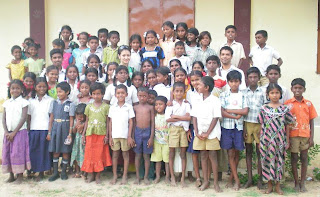Of the 193 million Children in the age group 6 to 14 years, 8.1 million children are out of school as of September 2004 as per Government statistics.
- Net primary enrollment ratio in 2001/02 : 83 7%
- Children reaching grade 5 in 2000/01 : 59 8 %
- Less than half of India's children between the age 6 and 14 go to school.
- A little over one-third of all children who enroll in grade one reach grade eight.
- At least 35 million children aged 6 - 14 years do not attend school.
- 53% of girls in the age group of 5 to 9 years are illiterate.
- In India, only 53% of habitation has a primary school.
- In India, only 20% of habitation has a secondary school.
- On an average an upper primary school is 3 km away in 22% of areas under habitations.
- In nearly 60% of schools, there are less than two teachers to teach Classes I to V.
- On an average, there are less than three teachers per primary school. They have to manage classes from I to V every day.
- High cost of private education and need to work to support their families and little interest in studies are the reasons given by 3 in every four drop-outs as the reason they leave.
- Dropout rates increase alarmingly in class III to V, its 50% for boys, 58% for girls.
- 1 in 40, primary school in India is conducted in open spaces or tents.
- In Andhra Pradesh (South India), 52 upper primary schools were operating without a building in 2002, while in 1993, there were none.
- In Maharashtra (West India), there were 10 schools operating without a building in 1993, this has climbed to 33 in 2002.
- More than 50 per cent of girls fail to enroll in school; those that do are likely to drop out by the age of 12.
- 50% of Indian children aged 6-18 do not go to school
Source: 7th All India Education Survey, 2002

A month after the 2004 Tsunami children ready for fishing
Camp Bell Bay - Great Nicobar - Andaman & Nicobar Islands
Early morning the shepherds take their cattle to the field
Sanand - Gujarat
 |
Every evening I visited few villages where I used to have conversation with the children of the fishermen community. In two years I managed to cover 12 villages in Mahabalipuram. Along with children we choose open spaces outside the village or near the beach for sessions or activities
Mahabalipiuram - Tamil Nadu
|
 |
Children of the scavengers in Manamadurai - Tamil Nadu
Scavengers are one of the most disadvantaged groups in India.
The scavengers involves manually cleaning dry pit latrines of human waste.
Women and girls performing this task crawl into the latrines with a broom and tin plate to clear it, the waste is then piled into a basket carried on their heads to a far away location.
This practice continues despite laws prohibiting it. (Source: Action Aid)
|
 |
Every evening I visited two villages in Mamamadurai and had sessions with children.
It took almost a year to complete the project with the children in 12 villages. These were the Dalit Children who were ill treated by teachers and the upper caste in their villages. |
A girl and younger brother on a way home after fishing
Pulicat Lake - Tamil Nadu
 |
These are the children of the Irulas from Kadalkanniyur village which lies beyond Koraikuppam in Pulicat Lake. The Irula people live there in a small village, population 65, set back in a grove of banyan and palm trees. The Irula are an isolated nomadic tribe or gypsy who speak Telugu, the language of the southern state of Andhra Pradesh. They were relocated by government to Kadalkanniyur before the tsunami in 2004. The Irula children attend school in Koraikuppam; their families are very glad they will have the chance to be educated and have a better life.
My friend and I were dropped off on the shore. Voices of children can be heard coming from the palm grove in the distance. The village is hard to get to. The usual dry, inlet bed is now filled with water, cutting off the pathway to the village. With help from Chittapa, the boatman, we were is ferried across, and walks past the banyan trees into the tiny concrete village of Kandalkanniyur.
Broad faces and sparkling eyes of adults and children welcome us outside the little community hall. Everyone piles in as the children form a circle, while adults sit behind. The windows are full of eager, curious onlookers.
The children are very sweet. They have always been isolated, on the fringe of acceptance and respect, with no place of belonging in society, class or caste. They slowly make their way in, towards themselves, to find voice and diamond presence, cultivating friendship and community along the way. ‘Confidence’ is not part of their social experience, yet they respond authentically and generously from a place of love and availability.
|
 |
| They happily escort us back to the boat. Some photos are taken and the boys run into the water to help push the boat off shore. They all stand, smiling and waving goodbye. Their hearts extend an invitation to come back soon. |
Back home from School
While visiting a village, I couldn't stop looking at these two little girls
holding hands together walking back home after school - Cuddalore - Tamil Nadu















